 Weird Stuff
Weird Stuff  Weird Stuff
Weird Stuff  Animals
Animals 10 Inspiring Tales of Horses Being Human
 Mysteries
Mysteries Top 10 Haunting Facts About the Ghost Ship MV Alta
 History
History 10 Surprising Stories About the Texas Rangers
 Humans
Humans 10 Philosophers Who Were Driven Mad by Their Own Theories
 Miscellaneous
Miscellaneous 10 Video-Game-Worthy Weapons and Armors from History
 Weird Stuff
Weird Stuff 10 Psychics Who Accurately Predicted Wartime Events
 The Arts
The Arts 10 Pieces of Art Inspired by a Broken Heart
 Health
Health 10 Science Fiction-Sounding New Medical Treatments
 History
History 10 Surprising Facts About the Father of Submarine Warfare
 Weird Stuff
Weird Stuff 10 Times Real Laws Were Based on Bizarre Hypotheticals
 Animals
Animals 10 Inspiring Tales of Horses Being Human
 Mysteries
Mysteries Top 10 Haunting Facts About the Ghost Ship MV Alta
Who's Behind Listverse?

Jamie Frater
Head Editor
Jamie founded Listverse due to an insatiable desire to share fascinating, obscure, and bizarre facts. He has been a guest speaker on numerous national radio and television stations and is a five time published author.
More About Us History
History 10 Surprising Stories About the Texas Rangers
 Humans
Humans 10 Philosophers Who Were Driven Mad by Their Own Theories
 Miscellaneous
Miscellaneous 10 Video-Game-Worthy Weapons and Armors from History
 Weird Stuff
Weird Stuff 10 Psychics Who Accurately Predicted Wartime Events
 The Arts
The Arts 10 Pieces of Art Inspired by a Broken Heart
 Health
Health 10 Science Fiction-Sounding New Medical Treatments
 History
History 10 Surprising Facts About the Father of Submarine Warfare
10 Bizarre Military Inventions That Almost Saw Deployment
There’s nothing quite like the prospect of a battlefield advantage to convince a general or politician to plow some money into a military project that might just work. As this list shows, however, innovation is always a gamble. For every radar or bouncing bomb, there are a handful of expensive, clunky duds.
Some of the most fascinating projects are the ones that almost came to fruition, whether through the determination of a convinced individual or the sheer possibilities that it could offer—if it would only work the way it’s supposed to. From a rocket-powered drum to a chicken-warmed nuke, these are the strangest military inventions to almost see deployment on the battlefield.
10 The Puckle Gun
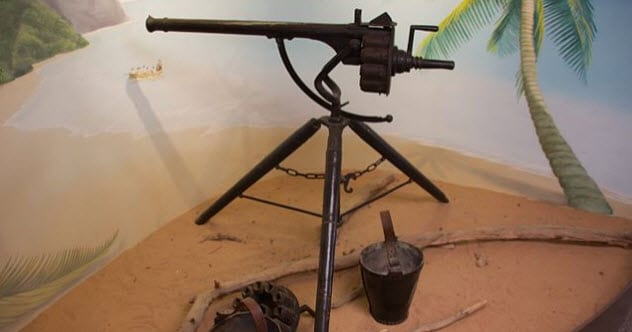
Invented in 1718 by British lawyer James Puckle, the Puckle gun was the world’s first patented multi-shot weapon. It fired at triple the rate of a soldier armed with a standard single-shot flintlock rifle or musket—yet with the same kind of accuracy and range.
It could even fire peculiar square bullets designed to cause maximum pain. The Puckle gun was massively ahead of its time. If it had been adopted and deployed by a major military, it would have changed the face of warfare, much like the Gatling gun did a century and a half later.
However, the Puckle gun was a victim of its own cleverness. It was unreliable and expensive to make. Its many complicated components made mass production impossible. Worst of all, it was impossible to fold into the military tactics of the time.
Even though it wasn’t a large weapon, it had to be stationary to fire. In addition, the time it took to break it down, move it to a new location, and set it up again proved simply too slow for the military leaders of the era. As a result, it was never adopted by a major world power.[1]
9 Pigeon-Guided Missiles

The pigeon-guided missile is exactly what it sounds like. It’s a World War II–era missile with three pigeons in the nose cone, with each bird trained to tap at the outline of a German Bismarck–class battleship. If the pigeon pecked in the center of its little screen, the missile flew straight. If it pecked off-center, the missile would alter course to get back on track.
Despite sounding ridiculous, the pigeon-guided missile was both fully functional and incredibly reliable. B.F. Skinner, the brain behind the idea, was a professor of psychology at Harvard University who was renowned for his behavioral experiments with rats. After developing the missile, he stated that he’d never use rats again because pigeons were so trainable.
The idea was fully tested but never used in combat. Skinner blamed the reluctance of generals to get behind the idea of a pigeon guiding an explosive. But in truth, he was beaten to the punch behind the scenes by another invention, radar-guided missiles.[2]
8 The Bat Bomb
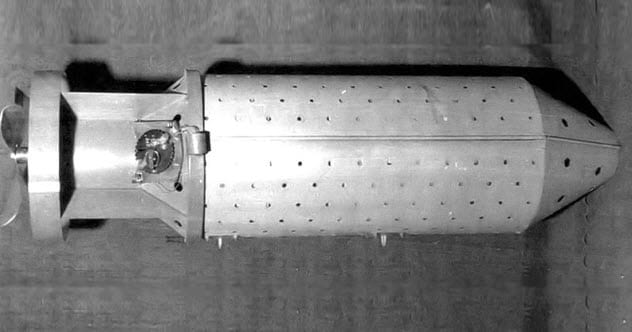
“Think of thousands of fires breaking out simultaneously over a circle of [64 kilometers (40 mi)] in diameter for every bomb dropped.” This was the fevered dream of Pennsylvania dentist Lytle S. Adams, who imagined Japan being devastated by a series of fires started by tiny incendiary devices delivered by hundreds of bats.
The idea didn’t arrive from nowhere. Adams was a keen spelunker and had been impressed by the bats he had seen on a recent trip to Carlsbad Caverns. When he heard the news that the Japanese had attacked Pearl Harbor, he cooked up his zany scheme and took it to his friend Eleanor Roosevelt.
As a result of Adams’s connection to Roosevelt, his bizarre plan was heard at a higher level than might be expected for a scheme that involved strapping bombs to bats. The National Research Defense Committee certainly warmed to the idea. Over time, “Project X-Ray” had over $2 million invested in it to solve the problems of bat transportation and simultaneous release.[3]
The bat bomb might have been a success if it had been fine-tuned enough, but the US military decided to move all its development resources to a far more powerful weapon. In the end, the atomic bomb was simply a higher priority than the bat bomb.
7 The Great Panjandrum

The Great Panjandrum, two 3-meter-wide (10 ft) rocket-powered wheels attached to a drum filled with explosives, was as peculiar and powerful in practice as it sounds. The Panjandrum was supposed to accelerate across a beach to the speed of a car and blow a massive hole in the German defenses that British troops and tanks could roll through.
Unsurprisingly, the rocket-powered speeding explosive was unpredictable in practice. The Panjandrum was critically unstable and could never be relied upon to go entirely in the direction in which it was pointed.
The designers tried adding a third wheel and steel cables for steering, but nothing really helped. On top of that, when the Panjandrum reached its top speed of 97 kilometers per hour (60 mph), the rockets had a habit of detaching.
Despite this, the Panjandrum was tested in front of top members of the military in January 1944. The test began well. The Panjandrum rolled through the surf in a straight line and began to accelerate. As it started to reach higher speeds, though, the rockets began to detach and fire off in all directions.
The Panjandrum became a spinning wheel of flames that nearly ran down the official cameraman. As the Great Panjandrum disintegrated into a flaming pile of wreckage on the beach, so did any hopes of it ever seeing real battlefield usage.[4]
6 Hajile
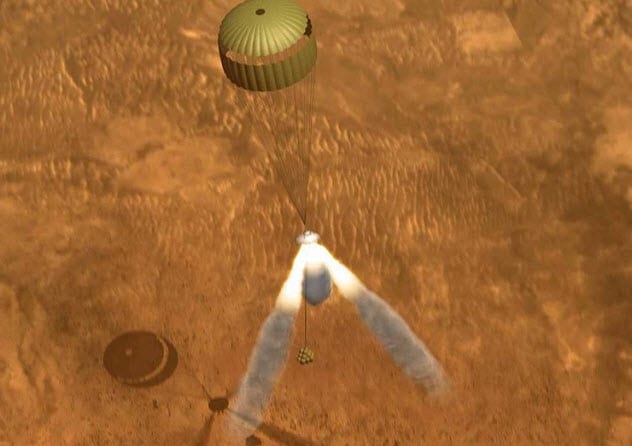
Hajile was created by the same minds that brought you the Great Panjandrum, and in terms of explosive failure, it reaches that high bar. An early retrorocket design, Hajile was created with the hope of using a rocket to slow the descent of supplies dropped from planes. This idea was recently used successfully to land the Curiosity rover on Mars (similar to image above), but the Hajile project was anything but a success.
The Hajile project was named as the reverse of “Elijah,” who ascended to heaven on a column of flame in the Bible story. Hajile was originally tested on concrete blocks with rockets strapped to them. When a dangling weight below the block hit the ground, the rockets would fire to slow the descent of the payload.
However, the first three tests were disasters. Twice, the rockets failed to slow the descent enough. On the third test, too much fuel relaunched the payload several dozen feet in the air.
The device was tested until it was successfully used, and eventually, two jeeps were donated by the United States Navy for real-world testing. One crashed into the ground at 48 kilometers per hour (30 mph), and the second was successfully landed with minimal damage as long as you count an upside-down jeep as a success.
Deeply unreliable, the project was shelved as World War II drew to a close.[5]
5 Nellie

“Nellie” (aka the “White Rabbit”) was a machine doomed from the start as it was designed to solve an obsolete problem. Nellie was an armored vehicle made to cut a trench through defensive works so that other machines could advance through the trench and bypass the defensive line.
As a pet project of Winston Churchill, work continued on the White Rabbit long after it became clear that it was not the only solution to the problems that tanks faced due to defensive structures.
As time went on, it became clear that Nellie wasn’t even a particularly good solution to these problems. It had a turning circle of 1.6 kilometers (1 mi) and was almost unable to be steered. Conditions inside the cramped cockpit were unbearable. Perhaps worst of all, serious questions were raised about the advisability of using a near-stationary machine with a long guiding trench behind it in the era of bombing runs.[6]
Despite Churchill’s enduring belief in the project, it was finally formally shelved in 1943. Churchill acknowledged that the project would have been mothballed years earlier if not for his promotion. In the end, he declared that he was “responsible but impenitent” for his misguided enthusiasm.
4 Maus
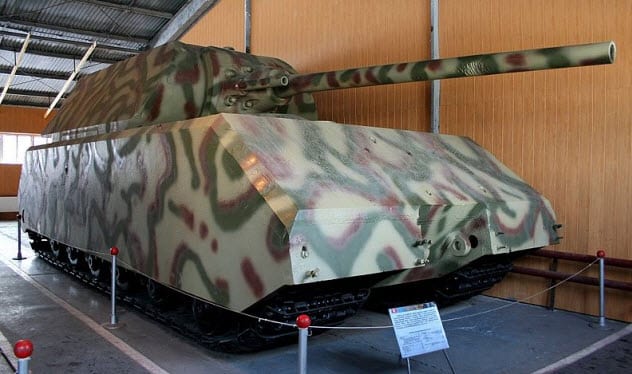
The Allies weren’t the only ones in World War II who had some bizarre ideas up their sleeves. Adolf Hitler particularly desired an indestructible superheavy tank. He proposed it in 1942, but few others at the top of the German military shared his enthusiasm for the idea. The Maus (“mouse”) was a 200-ton behemoth of a tank designed by Ferdinand Porsche, but it was plagued with mechanical problems from the start.
The driveshaft especially suffered from constant failures. Despite a massive Daimler-Benz aircraft engine powering the motors, the tank’s top speed was only 19 kilometers per hour (12 mph). It featured armor that was more than 23 centimeters (9 in) thick, but the Maus didn’t have a single machine gun to make it suitable for close combat—and the considered opinion of the top German brass was that it would find itself in close combat often.
There were plans to make 150 of these tanks, but the concerns of the generals couldn’t be overcome. In the end, only two prototypes were completed.[7]
3 The Coleoptere
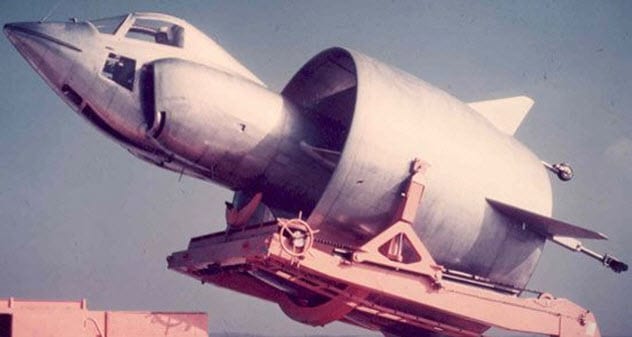
The Coleoptere (“beetle”) is one of the strangest-looking aircraft ever designed. With a ring-shaped wing wrapped around a fuselage, it was capable of vertical takeoff and landing. In fact, the designer theorized that it might be capable of supersonic speeds once it was airborne.
However, the Coleoptere had problems from its very beginning. In early hovering tests, pilot Auguste Morel complained that it was nearly impossible to determine his vertical height. He had to listen for changes in the engine’s hum to gauge the aircraft’s altitude. Even later versions of the Coleoptere had a distressing tendency to spin vertically.[8]
The only time that the Coleoptere achieved horizontal flight (instead of a vertical takeoff and landing) was accidental. On its ninth and final flight, the aircraft wobbled wildly during descent and ended up accelerating away horizontally—and briefly. The pilot ejected, the Coleoptere wrecked and burned up, and the project was discontinued.
2 The Blue Peacock
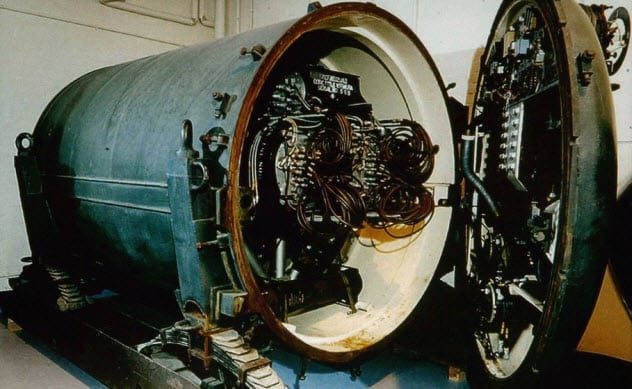
At first glance, the Cold War design of the Blue Peacock doesn’t seem too strange. A massive nuclear mine, it was designed to be buried by British forces in West Germany and detonated to stop a hypothetical Soviet invasion of Western Europe.
However, the design suffered from a major flaw. Buried deep underground, the device would inevitably get cold, and if it got too chilly, the detonator might not be able to set off a nuclear explosion.
The proposed solution is where things take a turn for the weird. The scientists in charge of the project suggested that chickens be buried inside the casing of the bomb with enough food to keep them alive for a week. The body heat produced by the chickens would be enough to keep the device functional.[9]
Perhaps the oddest part of the whole story is that wrapping a nuclear bomb in chickens isn’t what got the project shelved. In fact, it was fully accepted as a sensible solution to a peculiar problem.
The problem wasn’t the political tangle of burying nuclear bombs in an allied nation, either. It was simply that the British decided that the amount of nuclear fallout that would be produced by the Blue Peacock’s detonation would be unacceptably high.
1 The Gay Bomb

The idea of a “gay bomb” is a terrible marriage of awful science and rampant homophobia that seems like it belongs firmly in the 1950s. But as recently as 1994, the US Air Force’s Wright Laboratory requested a jaw-dropping $7.5 million to develop a chemical aphrodisiac that could be dispersed by an explosive and would cause “homosexual behavior” in enemy combatants.[10]
The whole idea was a failure on a scientific level. First, there is no known or proposed mechanism for a chemical causing heterosexual people to suddenly change their sexual orientation. Second, there’s also no known or proposed aphrodisiac chemical that’s ever had a measurable effect on the human body, let alone such a drastic one.
It was also a failure on a conceptual level as there’s no evidence that a big gay orgy would actually reduce troop morale. To the contrary, we already have plenty of evidence of excellent career soldiers who happen to be homosexual.
As this is the case, the funding was never delivered and the whole project thankfully never made it past the concept stage.
AJ lives in Stafford in the UK and has equally deep and abiding loves for weird science, horror stories, and good bourbon.
For more bizarre military inventions that never caught on, check out Top 10 Weapons That Sounded Better On Paper and 10 Creative Tank Designs That Never Caught On.








